Setting Type Buyer's Guide
Most jewelry is crafted from individual components. The pieces are often created on the jewelers' bench and then skillfully adjoined with molten precious metals. The components needed in most types of jewelry are incredibly simple. Even the most expensive tiffany-style diamond ring features just three pieces - the band of the ring, the head that mounts the prongs, and then finally the jewel itself. With a few peripheral components such as earring-posts, chains, and hinges (often known as "findings",) these basic components are used to make everything from solitaire and gem-set rings, to earrings, necklaces, pendants and more complex pieces. While the prong setting is the most frequently seen method of setting gems and diamonds, there are a variety of other methods also applied used to set jewels in precious metals.
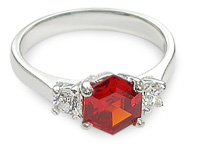
prong setting
Prongs are the most frequently seen method of setting gems in jewelry. Tiny little precious metal claws command a vice-like grip, which bends over the girdle of the gem to ensure its secure and enduring position.
Prong settings are frequently seen because they are relatively simple to work with. Easy to adjust to the size of an individual gemstone, prong settings usually feature anywhere from four to six prongs. However, marquise and trilliant cut gems can respectively have just two or three prongs at the corners where the points of the jewels are nestled in specialized v-shaped prongs.
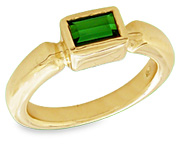
bezel setting
Securely encircling the the entire circumference of the gem, a bezel is a crafted diskette of metal that holds the gemstone by its girdle to the ring. An age old technique that can appear very contoured and modern, it is labor intensive and must be crafted to precisely circumnavigate the outline of the gem.
A variation of the bezel setting is the flush or gypsy setting. The surface of the ring has a window cut into it that exactly fits the size of the gem. Secured from underneath, the crown of the gem rises from the ring beautifully catching rays of light.
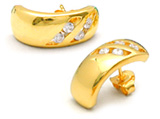
channel setting
Often seen in eternity bands and tennis bracelets, gemstones are held side-by-side by their girdles between two long tracks of precious metal. When used with square, princess and rectangular shaped jewels, the effect is breathtaking as no metal appears between the jewels – they appear to float in a tightly bejeweled chain within the jewelry.
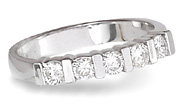
bar setting
An increasingly popular setting style. Bar settings feature diamonds or gemstones individually set between short bars that run like a railway track across the ring. Each gem is set between the two small parallel bars, and the sides of the gems are left open. This open sided technique maximizes the amount of light entering the gems, which creates superior brilliance and sparkle.
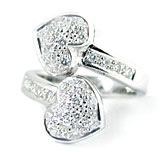
pave setting
Pave setting produces a carpet of brilliance across the entire surface of a piece of jewelry. The surface is encrusted, or quite literally “paved” in diamonds and gems, and the body of the jewelry is vibrantly brought to life.
Pave setting is often used in conjunction with white gold, which further creates an effect of the whole piece of jewelry being crafted from diamonds. While regularly seen in yellow gold, the pave technique is rarely used in platinum. The settings are either created by use of tiny prongs that hold the jewels on both sides, or are crafted by scooping beads of precious metal out to hold the gems in place.

Free Shipping
Free shipping to the US or CAN for orders of $500 or more.

Best Quality
We are renowned for selling the best gems and jewelry.

Best Offers
Unlock exclusive offers and be the first to know of new arrivals

Secure Payments
Exclusive financing options. All transactions are SSL protected.
